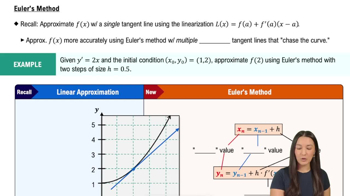6. Evaluate ∫ cos x √(100 − sin² x) dx using tables after performing the substitution u = sin x.
Table of contents
- 0. Functions7h 54m
- Introduction to Functions16m
- Piecewise Functions10m
- Properties of Functions9m
- Common Functions1h 8m
- Transformations5m
- Combining Functions27m
- Exponent rules32m
- Exponential Functions28m
- Logarithmic Functions24m
- Properties of Logarithms36m
- Exponential & Logarithmic Equations35m
- Introduction to Trigonometric Functions38m
- Graphs of Trigonometric Functions44m
- Trigonometric Identities47m
- Inverse Trigonometric Functions48m
- 1. Limits and Continuity2h 2m
- 2. Intro to Derivatives1h 33m
- 3. Techniques of Differentiation3h 18m
- 4. Applications of Derivatives2h 38m
- 5. Graphical Applications of Derivatives6h 2m
- 6. Derivatives of Inverse, Exponential, & Logarithmic Functions2h 37m
- 7. Antiderivatives & Indefinite Integrals1h 26m
- 8. Definite Integrals4h 44m
- 9. Graphical Applications of Integrals2h 27m
- 10. Physics Applications of Integrals 3h 16m
- 11. Integrals of Inverse, Exponential, & Logarithmic Functions2h 34m
- 12. Techniques of Integration7h 41m
- 13. Intro to Differential Equations2h 55m
- 14. Sequences & Series5h 36m
- 15. Power Series2h 19m
- 16. Parametric Equations & Polar Coordinates7h 58m
7. Antiderivatives & Indefinite Integrals
Indefinite Integrals
Problem 8.R.1e
Textbook Question
Explain why or why not. Determine whether the following statements are true and give an explanation or counterexample.
e. The best approach to evaluating ∫(x³ + 1)/(3x²) dx is to use the change of variables u = x³ + 1.
 Verified step by step guidance
Verified step by step guidance1
Step 1: Begin by analyzing the integral ∫(x³ + 1)/(3x²) dx. Notice that the numerator (x³ + 1) and the denominator (3x²) suggest a potential simplification using substitution.
Step 2: Consider the substitution u = x³ + 1. Compute the derivative of u with respect to x: du/dx = 3x². Rearrange this to express dx in terms of du: dx = du/(3x²).
Step 3: Substitute u = x³ + 1 and dx = du/(3x²) into the integral. The numerator (x³ + 1) becomes u, and the denominator (3x²) cancels out with the dx substitution. This simplifies the integral to ∫u * (1/(3x²)) * (du/(3x²)).
Step 4: Evaluate whether the substitution fully simplifies the integral. In this case, the substitution u = x³ + 1 does not eliminate the x² term in the denominator, which remains problematic for direct evaluation. This suggests that the substitution u = x³ + 1 is not the best approach.
Step 5: Conclude that the substitution u = x³ + 1 is not ideal for this integral. A better approach might involve simplifying the integrand directly or exploring alternative substitutions that fully eliminate x from the integral.
 Verified video answer for a similar problem:
Verified video answer for a similar problem:This video solution was recommended by our tutors as helpful for the problem above
Video duration:
3mPlay a video:
Was this helpful?
Key Concepts
Here are the essential concepts you must grasp in order to answer the question correctly.
Integration Techniques
Integration techniques are methods used to find the integral of a function. Common techniques include substitution, integration by parts, and partial fractions. Understanding these methods is crucial for determining the most efficient way to evaluate an integral, as different functions may require different approaches.
Recommended video:

Integration by Parts for Definite Integrals
Substitution Method
The substitution method is a technique used in integration where a new variable is introduced to simplify the integral. By substituting u for a function of x, the integral can often be transformed into a more manageable form. This method is particularly useful when the integrand contains a composite function, making it easier to integrate.
Recommended video:

Euler's Method
Evaluating Integrals
Evaluating integrals involves finding the antiderivative of a function, which can be a straightforward or complex process depending on the function's form. The goal is to determine the area under the curve represented by the function. Understanding how to evaluate integrals accurately is essential for solving problems in calculus, especially when determining the validity of statements regarding integration methods.
Recommended video:

Evaluate Logarithms

 5:04m
5:04mWatch next
Master Introduction to Indefinite Integrals with a bite sized video explanation from Patrick
Start learningRelated Videos
Related Practice
Textbook Question
9
views
